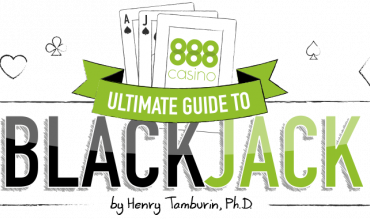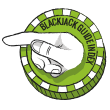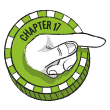LEGENDS OF BLACKJACK

This chapter summarizes the individuals who have made major contributions to our knowledge of blackjack and what those contributions were. You’ll also learn about the Blackjack Ball, an annual event attended by professional players from around the world, who the individuals are in the Blackjack Hall of Fame (BJHOF), how they got elected, and where the BJHOF is located.
![]()
MAJOR CONTRIBUTORS TO OUR KNOWLEDGE OF BLACKJACK
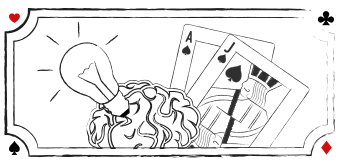
You might deem it strange that I included this chapter in my Guide. The reason I did is because I believe many of you reading this, and most other casino players, have little or no knowledge of the history of blackjack and no perspective of what came before. Therefore, I believe it was important to recognize those individuals who have made major contributions to our knowledge of winning blackjack play, because if it weren’t for them, the game of blackjack would be just another casino game with the odds stacked against the player, rather than a game that can be beaten by a skillful player. I’ve listed the individuals below, chronologically, along with their contributions.

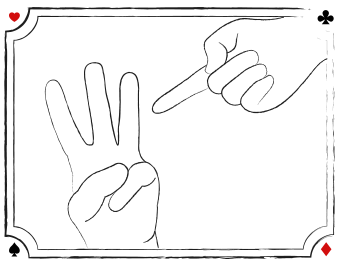
ROGER BALDWIN, WILBERT CANTEY, HERBERT MAISEL, AND JAMES MCDERMOTT
These mathematicians, often referred to as “The Four Horsemen of Aberdeen,” in the literature, used hand calculators to develop and publish a reasonably accurate basic strategy for playing your hands. They proved that blackjack offered the best odds of winning if players would follow a specific set of rules. Their work was published in 1956 in the Journal of the American Statistical Association and later in the book, Winning Blackjack.

ED THORP
Thorp was the first to publish a method of winning at blackjack called “card counting.” He proved that the cards do have a “memory,” and that by tracking certain cards it’s possible to tell whether the deck is player favorable or unfavorable. Thorp published his theories, including his famous “Ten Count” card-counting system, in the 1962 classic book Beat the Dealer, which became wildly popular, reaching the New York Times best-seller list. The casino industry panicked after the publication of the book and changed its playing rules even though the Ten Count was too difficult for average players to master. After players boycotted the game, the casino industry reluctantly reinstated the original rules. It turned out that the publication of the book actually increased the popularity of blackjack and casino profits, because players flocked to the tables to play the “beatable” game, even though they didn’t possess the skills to do so. Not everyone, however, believed that card counting worked. John Scarne, who was a well-respected gambling expert and author during this time, publicly criticized Thorp’s “unbeatable winning blackjack system.” Nevertheless, Thorp is widely considered to be the “Godfather of Card Counting.”
HARVEY DUBNER
Dubner is generally credited with developing the practical point-count system that he called Hi-Lo, which was much simpler than Thorp’s Ten Count. I covered point-count system Hi-Lo in detail in Chapter 10.4 but, as a reminder, the small cards from 2 through 6 are tagged “plus one,” the large cards (10s, picture cards, and Aces) are tagged “minus one,” and the neutral 7 through 9 cards are tagged “zero.” Players simply add the tags of each card as they are played and the arithmetic sum, known as the running count, tells the player whether he has the advantage (positive running count ) and should bet more, or the house has the advantage (negative running count) in which case he should bet small. Dubner presented his point-count system in 1962 to the Fall Joint Computer Conference in Las Vegas. The Hi-Lo point-count system is still used today by a majority of card counters. You will also need to download the gambling software to your computer. The gambling site will have instructions on how to do this. (Note: Some sites also allow you to play using your web browser; again read the instructions on the site if this option is available.) You’ll also need to set up a user name and password to access the gambling software and your account.
JULIAN BRAUN
Braun was the first to apply high-speed computers to the analysis of blackjack. Braun was a computer programmer for IBM and he had access to the fastest mainframe computers of his time. Braun tested and refined the original basic playing strategy. He also created the playing indices for the Hi-Lo counting system and published them in Thorp’s second edition of Beat the Dealer. Braun also collaborated with Lance Humble to develop the Hi-Opt I and II card-counting systems (published in 1980 in the World’s Greatest Blackjack Book), and with Lawrence Revere to develop more sophisticated counting systems that appeared in Revere’s book, Playing Blackjack as a Business. Braun’s only published book was How to Play Winning Blackjack, which contained the complete Hi-Lo counting system for single- and multiple-deck games.
LAWRENCE REVERE (AKA LEONARD “SPECS” PARSONS AND GRIFFITH K. OWENS)
Revere was a casino pit boss before he turned to playing blackjack professionally and teaching card counting to students. He developed and promoted several card-counting systems including his Advanced Point Count (A.P.C.), which was one of the most popular counting systems used by professionals during this time. In 1969, he published his classic book, Playing Blackjack as a Business, considered by many to be one of the best tutorials on how to win at blackjack. The book contained a series of simple-to-read-and-understand, color-coded strategy charts (first of their kind), which made it easy for average players to learn the strategies.
CHARLES EINSTEIN, LANCE HUMBLE, AND CARL COOPER
The earlier counting systems of Thorp, Dubner, Revere, and Braun treated the ace as a high card. In 1968, Charles Einstein suggested treating the ace as zero, since for playing purposes, the ace acts like a low-value card. He also suggested keeping a separate count of the ratio of aces to non-aces, and recommended departures to the basic playing strategy based upon the count. Einstein’s concept was refined by Braun and later published in Lance Humble and Carl Cooper’s book, The World’s Greatest Blackjack Book.
ALLAN WILSON
Wilson published the first-of-its-kind study on risk of ruin in his classic book, The Casino Gambler’s Guide. Since then the important concept of Gambler’s Ruin and Risk of Ruin for advantage blackjack players has been studied and refined most notably by Don Schlesinger, who made the trip risk of ruin and other formulas widely known when he published them in his classic book, Blackjack Attack.
(Note: Risk of Ruin is covered in Chapter 10.13.)

PETER GRIFFIN
Griffin was a university professor who conducted detailed mathematical analyses of the game of blackjack. His book, The Theory of Blackjack, was first published in 1978 and it has become the premier reference work on the mathematics of blackjack for students of the game. Among many of his notable achievements, he developed two factors that allowed an accurate comparison of a blackjack count system’s win rate: Betting Correlation (BC) and Playing Efficiency (PE). Griffin was also credited with being the first person to determine that the casino had an overall advantage of about 2% over a typical customer playing blackjack during that era.
JOHN GWYNN
Gwynn was a university professor, computer programmer, and colleague of Peter Griffin, who conducted detailed computer studies of different aspects of the game with blackjack pioneers Griffin, Arnold Snyder, and Schlesinger. Gwynn is most known for his ambitious computer simulation to unravel the great “Floating Advantage Debate,” in collaboration with Schlesinger, and for his “How True Is Your True Count?” study, conducted with Snyder.
AL FRANCESCO
Francesco, a pseudonym, is the pioneer of the concept of blackjack team play, where teams of players pooled their bankrolls and used various card-counting techniques to win large sums of money from casinos around the world. Francesco taught the famous Ken Uston (see below) how to count cards, and he eventually joined one of Francesco’s blackjack teams and then later exposed some of their secrets in his first book, The Big Player. Other teams have used the team concept to win large amounts of money at blackjack, the most notable being a team of MIT students described in the best-selling book, Bringing Down the House, and in the movie 21.
KEN USTON
Uston is considered to be the most famous blackjack player of all time. For two decades he played professionally for high stakes winning millions of dollars utilizing a vast array of techniques including card counting, teams with “Big Players,” hole-card play, and concealed computer play. He achieved celebrity status and appeared on several television shows, including “60 Minutes.” He fought the casinos not only on the tables but in the courts to assure the rights of card counters to play in Atlantic City. His book Million Dollar Blackjack is a classic on how to win at blackjack.
KEITH TAFT
Taft invented the world’s first concealed blackjack microcomputer, a device about the size of a pack of cigarettes that a player could strap to his body and secretly use in the casino to play virtually perfectly (there were no laws back then that disallowed these devices). Taft hooked up with Uston, who used the device in his team play (the computer was nicknamed “George”). They were eventually caught by the casinos and accused of using a cheating device. (Note: You can view Taft’s computer at the Blackjack Hall of Fame. See Chapter 16.3.)
IAN ANDERSEN
Andersen was a high-stakes professional blackjack player. In 1976 he wrote the classic book, Turning the Tables on Las Vegas, which described in detail new techniques to allow card counters to disguise their skills from casino bosses. His sequel, Burning the Tables in Las Vegas, was published in 1999. He is famous for his “Ultimate Gambit,” which was a new approach to winning at blackjack that incorporated camouflage in playing, betting, and behavior decisions.
TOMMY HYLAND
Tommy Hyland has a long record of managing successful card counting teams. He began playing blackjack in 1979, and shortly thereafter, playing and managing blackjack teams have been his full time job. Some of Hyland’s teams had up to 30 members. Besides being an excellent card counter, Hyland’s strengths have been his recruiting and training of new players for his teams, and his ability to successfully manage large (and small) teams. Hyland’s team is still active today.

STANFORD WONG
Wong’s mathematical analyses of blackjack and his contributions to the game are legendary. His book Professional Blackjack is considered the bible for “wannabe” card counters. The book contained the first count indices for surrender, and strategies for games where the dealer stood on soft 17, as well as the level-3 Halves point count system. Wong’s computer program “Blackjack Analyzer” was one of the first commercially available software programs to study the game of blackjack. In 1997, he launched www.bj21.com on the Internet, which contained blackjack message boards. Wong also developed playing and betting techniques for blackjack tournaments, which he published in his classic book Casino Tournament Strategy. His book Winning Without Counting contained the first published non-counting techniques to beat the game of blackjack, and his book Basic Blackjack contains the most comprehensive discussion of basic strategy. The term “Wonging” is used to designate a specific advantage-play technique. Wong also published several newsletters on blackjack, the most famous, Current Blackjack News, which has been published continuously, since its inception in 1979.
ARNOLD SNYDER
Beginning in 1981, Snyder published Blackjack Forum (BJF), a well-respected quarterly trade journal for professional gamblers. Many new revelations in playing techniques for serious blackjack players first appeared in BJF. Snyder was one of the first blackjack researchers to publish the importance of deck penetration (i.e., percentage of cards played before the shuffle) on a card counter’s win rate, and suggested that simpler card-counting systems will not radically affect earnings. His Red Seven Count system was one of the first published unbalanced counting systems that appeared in BJF and his book Blackbelt in Blackjack. Snyder also conducted research on the advanced playing technique known as shuffle tracking, and published the first mathematical analysis of different types of blackjack shuffle tracking in his book The Blackjack Shuffle Tracker’s Cookbook. Many of Snyder’s articles can be found on www.blackjackforumonline.com. Arnold Snyder will always be remembered as the self-appointed “Bishop of the First Church of Blackjack,” where he gave his “sermons” four times a year in BJF.
DON SCHLESINGER
Schlesinger is a well-respected blackjack mathematician, and author of the blackjack bible, Blackjack Attack: Playing the Pros’ Way. His understanding of the game of blackjack is unparalleled in this business. He has studied and answered many thorny mathematical problems that have puzzled serious players for years, including optimal betting, camouflage, risk analysis, systems comparisons, and much more. Schlesinger simplified the popular Hi-Lo card-counting system when he published his “Illustrious 18” and “Fab 4” (instead of card counters’ memorizing 50 or more strategy indices, he showed that you need learn only 20 or so indices to capture most of the available advantage). His innovative SCORE technique is used by serious players to compare the win potential of different games and counting systems, and his work on bankroll determination and risk of ruin calculations has become legendary. Schlesinger also developed the most accurate basic strategy cards available for the public (Ultimate Blackjack Strategy Cards). He is a regular contributor to blackjack message boards, helping both novice and experienced players with questions that they have about the game, and he is a valued consultant to blackjack authors and researchers everywhere.
MIT BLACKJACK TEAM
In the 1980s, a team of MIT students won millions playing blackjack using card counting and the team approach of play originally developed by Al Francesco. The most famous players on the MIT Team were Johnny Chang, Mike Aponte, and Dave Irwin. The exploits of the MIT team are chronicled in Ben Mezrich’s best-selling book Bringing Down the House, and in the movie version of the book (21, featuring Kevin Spacey).
MAX RUBIN
In 1994, Rubin published the innovative book Comp City, which showed for the first time how blackjack players can get more than their fair share of free casino comps by giving the perception that they are giving the casino a lot of action. He also created and hosts the Blackjack Ball (see Chapter 16.3). Rubin has appeared on a number of gambling-related TV shows as an expert commentator, and as an analyst on blackjack tournament shows.
JAMES GROSJEAN
James Grosjean is a well-respected and highly successful professional blackjack player, author of the books Beyond Counting: Exploiting Casino Games from Blackjack to Video Poker and Exhibit CAA, and the youngest person to be inducted into the Blackjack Hall of Fame. He is also well known for his recent legal victories over several major casinos and a casino investigative company, for illegal detention. Grosjean continues to play blackjack in casinos around the world. Because he won three years in a row, he also has been banned from competing in the Blackjack Ball competition for the “World’s Greatest Blackjack Player.” (The winner of the competiton receives a cup that was renamed the Grosjean Cup to recognize his achievement.) Grosjean also writes a blog on www.gamblingwithanedge.com.
There are, to be sure, more innovators that have made a positive impact on the game of blackjack. I’ve listed them below. History will determine if they achieve the status of legends of the game.
OLAF VANCURA AND KEN FUCHS
In 1998, Vancura and Fuchs developed the K-O Blackjack counting system, an unbalanced system that was much easier for average players to master than conventional balanced card-counting systems, because it eliminated the mental conversion of the running counting to true count. They published their K-O Counting System in the book Knock-Out Blackjack, which became a best-seller.
MICHAEL DALTON
Dalton is best known for his book Blackjack: A Professional Reference (now called Encyclopedia of Casino Twenty-One) and his Blackjack Review magazine, which was published from 1992 through 1998. He currently maintains a public website for blackjack and poker players at www.bjrnet.com.
GEORGE C.
George C. has been a high-stakes blackjack player for over 50 years. He is best known for his book Shuffle Tracking for Beginners and his development of the The Unbalanced Zen II counting system. George conducted pioneering research in risk of ruin formulas, which formed the basis of Chapter 8 in Schlesinger’s Blackjack Attack.
KAREL JANECEK
Janecek is a well-respected blackjack mathematician, who developed the famous Statistical Blackjack Analyzer (SBA) software simulator that allowed blackjack researchers to conduct simulations of billions of hands in 15 minutes (or less).
JOHN AUSTON
Auston developed the Blackjack Risk Manager program that instantly performs blackjack risk-related statistical calculations, allowing skilled players to manage their bankroll risk. Auston was also involved in the first risk-of-ruin calculations and the “World’s Greatest Blackjack Simulation” (800 billion hands) contained in Schlesinger’s Blackjack Attack.
NORM WATTENBERGER
Wattenberger is one of the foremost blackjack software developers, and his Casino Vérité software program is used by many researchers and serious players for analyzing virtually any problem associated with blackjack. His software programs have incredible graphics and are used by many players to improve their game. Many of Wattenberger’s computer studies are posted on his web site www.qfit.com and in “Modern Blackjack,” his free online treaties on the game.
DAN PRONOVOST
From 2003 to 2005, Pronovost developed Speed Count, a simple counting system for the masses of average blackjack players that allows them to easily play with an advantage over the casino. As discussed in Chapter 10.9, Speed Count tracks the number of low cards per hand, rather than the traditional counting metric of low cards to high cards, and requires less mental concentration than traditional counting systems. Pronovost was also the first to develop blackjack training programs for hand-held devices and PDAs, such as Palm OS and Pocket PCs, and his blackjack training software is also available for Andriod and iPhones (www.handheldblackjack.com).
To be sure, there are more players that have made major contributions to blackjack but space requirements limit how many I can acknowledge (see Chapter 16.2 for those players who were voted into the Blackjack Hall of Fame). If you want to read true stories about players who “crushed the casinos” with their skillful play, I recommend you read the ebook Legends of Blackjack: True Stories of Players Who Crushed the Casinos by Kevin Blackwood and Larry Barker (available in Kindle).
DON JOHNSON
In 2014, Don Johnson made history by “crushing” several Atlantic City casinos to the tune of 15 million dollars by taking advantage of their loss rebate programs and using other “proprietary” advantage-play techniques. As a result of his feat, Johnson became one of the most famous blackjack players in the world. Decades earlier, Johnson quietly reaped extraordinary profits from casinos by executing several other advantage plays. At the 2017 Blackjack Ball, Johnson was voted into the Blackjack Hall of Fame by his peers
KEY TAKEAWAYS
- There have been many contributors to our knowledge of winning blackjack strategy
- If it weren’t for these contributors, the game of blackjack would be just another casino game with the odds stacked against the player, rather than a game that can be beaten by a skillful player
BLACKJACK HALL OF FAME
The Blackjack Hall of Fame (BJHOF) acknowledges and honors the greatest contributors in history to the game of blackjack. In this chapter, you’ll learn who are the members of the Hall of the Fame, how they got inducted, what their contributions were, and where the Hall of Fame is located.
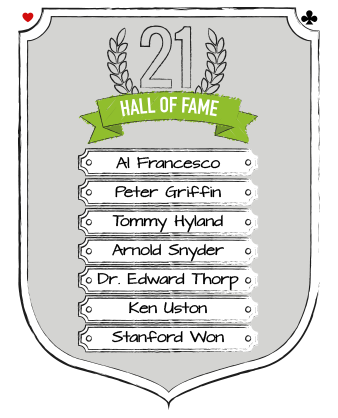
HISTORY OF HALL OF FAME
Max Rubin came up with the idea of the Blackjack Hall of Fame in 2002. He polled scores of top players, authors, publishers, casino managers, and gaming consultants to determine the original 21 potential nominees. Rubin then contacted scores of blackjack experts to secure “absentee ballots” and also had public “open voting” in which readers of several consumer gaming publications were allowed to vote. (The public’s votes counted as two ballots in the final tabulations.)
Rubin then distributed ballots at the 2003 Blackjack Ball (discussed in Chapter 16.3) and each attendee that was either a professional blackjack player or “contributor to the craft,” was directed to choose seven of those 21 original nominees. The results were tallied, and the nominees chosen to be honored as the “Inaugural Class” of members in the Blackjack Hall of Fame were:
Every year, Rubin contacts the Hall of Famers to discuss, agree, and vote on a slate of seven nominees, which is distributed to the invited attendees at the following Blackjack Ball. Each qualified attendee (player or contributor) voted for two nominees (this will be reduced to one beginning in 2017). Along with the absentee ballots sent to scores of top pros and others, the votes are tallied and the nominee with the most votes is then enshrined into the BJHOF
As of 2022, there are 30 members in the BJHO; 21 are still living (and many attend the Blackjack Ball). Interestingly, many of the members in the BJHOF can only practice their craft by remaining anonymous; hence, many members have been enshrined in a name that isn’t truly theirs.
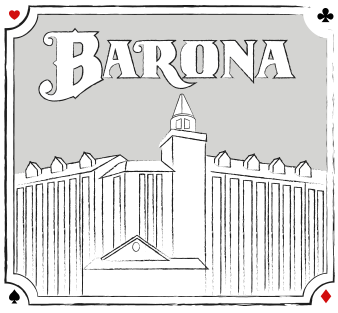
The Blackjack Hall of Fame is located at Barona Casino (San Diego, CA). This was the result of Max Rubin’s approaching senior management and suggesting that they become the home of the Blackjack Hall of Fame and honor the professionals’ accomplishments by not only showcasing them at the Hall of Fame, but also by providing them with unlimited Room, Food, and Golf privileges for life … with only one stipulation: that they never play at the casino’s blackjack tables.
(Note: Barona also sponsors the Blackjack Ball and attendees also agree not to play there as well..)
Currently, there are 24 photographs of the members in the BJHOF (with three more planned), which get changed every so often. Additionally, there are a revolving series of displays showcasing both legal gaming apparatus (such as Keith Taft’s original blackjack computer and “toe-typing” shoes dating back to 1971, which was legal at that time), to all kinds of cheating gear (such as the current display presenting a variety of “gaffed” dice, shiners, cheater’s hold-out devices, and blackjack shoes with built-in prisms).
BLACKJACK HALL OF FAME
Below is the list of the honorees, the year they were inducted into the Hall of Fame, and a brief description of their accomplishments.
| HONOREE | YEAR INDUCTED | ACCOMPLISHMENTS |
|---|---|---|
| Al Francesco | 2002 | Invented the concept of the Big Roger team strategy. |
| Tom mg Hyland | 2002 | Long record of managing successful card-counting teams. |
| Peter Griffin | 2002 | Mathematics professor who studied the math of blackjack and wrote the classic book The Theory of Blackjack |
| Arnold Snyder | 2002 | For 20 years, edited the quarterly Blackjack Forum for professional. players.Wrote several books an blackjack including his Latest, The Big Book of Blackjack. |
| Edward Thorp | 2002 | Invented card counting and wrote the classic best-selling book Beat the Dealer. |
| Ken Usion | 2002 | A professional player who popularized the technique of team ploy; appeared on TV ShOW 60 minutes: successfully sued Atlantic OW casinos for the rights of all card counters; author of several books including Million Dollar Blackjack. |
| Stanford Wong | 2002 | Successful high-stakes blackjack plower who mate the classic book Professional Blackjack: invented the practice called "wonginr. owner of P1 Yee Press publishing corn ponw, publishers of the monthly "Current Blackjack News." |
| Max Rubin | 2004 | Showed how to get the edge bij taking advantage of casino comps', author of the classic book Comp City; provided color commentary on televised blackjack tournaments. |
| Keith Taft | 2004 | Invented the first wearable blackjack computer (named 'George'). |
| Julian Braun | 2005 | Used a computer to study blackjack and developed simpler card counting systems. He authored How to Play Winning Blackjack. |
| Lawrence Revere | 2005 | Wrote the first book on card counting written by a professional player (Playing Blackjack as a Business). |
| James Grosjean | 2006 | Youngest member of the Hall of fame, he Is a brilLiont mathematician who perfected techniques of hole carding, shuffle tracking, and other advanced playing techniques. Authored the classic book Beyond Counting & Exhibit CAA. He also wan a suit for being accused of cheating against Caesars Palace and Griffin investigations. essentially bankrupting the Latter, Three-time winner of the Blackjack Ball corn petinon and currently banned from plowing. Writes the advantage-play blog on gamblingnwithanedge.com. |
| John Chang | 2007 | Player and Manager on the famous MIT Card Counting team; portrayed in the Hollywood movie "21." |
| Roger Baldwin, Wilbert Cantey, Herbert Maisel, James McDerrricint | 2008 | Using onty desk calculators white stationed at the Aberdeen Proving Ground, they invented the first reasonably accurate basic playing strategy. Forever known as the 'Four Horsemen of Aberdeen" |
| Richard Munchicin | 2009 | A professional card counter who authored the book Gambling Wizards. Co-hosts the weekly podcast "Gambling with an Edge," |
| Darryl Purpose | 2010 | High-stakes player who was a key member of Uston's (and other) card counting teams. |
| Zeljka Ronogajec | 2011 | First international inductee Into BJHOF: card counter extraordinaire, heis alleged to be one of the biggest gamblers In the world. |
| Ian Andersen | 2012 | Authored the classic book Turning the on Tables Las Vegas, containing the first practical guide on blackjack camouflage; also authored Burning the Tables In Las Vegas |
| Bob Nersesian | 2013 | Lawyer who defends card counters who run Into difficulties with casinos; wrote the books Beat the Players and The Law fur Gamblers, Was the Lead counsel in Grosjean's suit. |
| Don Schlesinger | 2014 | His understanding of the game of blackjack is unparalleled; studied and published data on optimal betting, camouflage, risk analysis, systems comparisons, and much more. developer of the illustrious 18, offers advice and answers blackjack players questions on Internet message boards; and author of the classic book Blackjack Attack: Playing the Pros' Way. |
| Bill Beater | 2016 | One of the brightest minds in blackjack early) shuffle- and ace-tracker, involved in massive projects with covert legal blackjack computers; became an expert in analyzing and betting on horses. |
| Don Johnson | 2017 | One of the most famous blackjack players in the world, who beat three Atlantic City casinos for $15 million by pummeling their toss rebate programs. |
| Wally Simons | 2018 | Used sophisticated techniques before they were well-known to win countless millions of dollars. Developed some of the first electronic shuffle tracking computers that harvested additional millions. |
| Rob Reitzen | 2019 | Beaten blackjack games in more innovative ways than most professional blackjack players ever known to exist. Founding partner of CORE, which became the largest and most profitable player banking operation in history. Once beat a Las Vegas Strip casino for $500,000 in one weekend with a reporter in tow. |
| Anthony Curtis | 2020 | 42-year career as a professional player in blackjack, casino tournaments, sports, and other forms of gambling. Additionally, the most successful publisher of professional gambling books in history, with over 100 titles to his credit. Unequivocally, the most famous gambling expert in the world featured on countless high-profile television programs, and a consultant/writer for scores of print media companies. |
| Cat Hulbert | 2022 | She played on the Czech blackjack team in over 300 casinos worldwide and was the first woman to ever amass a million dollars across the blackjacktables. Selected by Card Player Magazine in 1996 as one of the best and smartest card players in the world. She was one of only eight professional players featured in the Gambling Wizards book. |
| Blair Hull | 2022 | A big player in Al Francesco’s highly successful blackjack team in the mid-‘70s. then played solo in 1971 and continued to run his team in the late ‘70s. Founded Hull Trading, one of the world’s premier market-making forms, which he later sold to Goldman Sachs for $531 million. Responsible for the Blackjack Hall of Fame’s success in forming its own 501-C3 Charitable Foundation. Recipient of the first “Ed Thorp Lifetime Achievement Award.” |
| Maria “The Greek” | 2023 | Co-founder, and one-time manager, of “The Greeks” card-counting team. She recruited only the top talent and guided the team into winning countless millions using a “slash and burn” technique to become the most successful card-counting team this century. She also is the only woman to have ever won the coveted title of the “World’s Best Blackjack Player.” |
| Rick "Night Train" Blaine | 2024 | Blaine took professional play as a part-timer to new levels while staying under the casinos' radar. He is often sought out as a player by high-stakes blackjack teams, and based on the latter experience, he organized and managed several teams. Blaine is the author of Blackjack Blueprint: How to Play Like a Pro ... Part Time, which many consider the most comprehensive book on the game. |
Note: Thanks to Max Rubin for some of the information contained in this chapter.
KEY TAKEAWAYS
- Max Rubin came up with idea for the Blackjack Hall of Fame in 2003
- First seven inductees were selected by blackjack players and “contributors to the craft” at the 2003 Blackjack Ball
- Mostly every year, nominees are selected into the BJOF at the annual Blackjack Ball
- As of 2022, there are 30 inductees into the BJ HOF
- The physical location of the BJHOF is in the Barona Casino where photos and a brief description of each honoree are posted.
- Blackjack Hall of Famers (as well as attendees to the Blackjack Ball) are comped for life at Barona with free rooms, food, and drinks with one proviso: they are not allowed to sit down and play blackjack in their casino.
BLACKJACK BALL
This chapter will give you an inside look at the annual event attended by blackjack pros from around the world, many of whom have made a fortune playing blackjack.
(Note: I’ve attended the Blackjack Ball many times.)
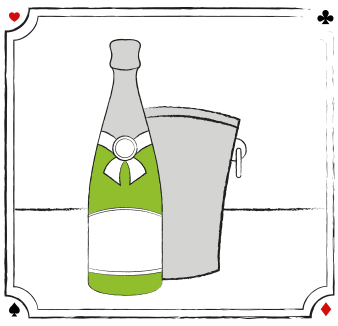
WHAT IS THE BLACKJACK BALL?
The Blackjack Ball is an annual gathering of professional blackjack players (active and retired), writers, mathematicians, and other contributors to our knowledge of blackjack. The event has been held for the past 25 years hosted by Max Rubin and sponsored by Barona Casino.
What began as a sparse gathering of blackjack pros in Max Rubin’s home in 1997, the Blackjack Ball soon outgrew that venue and moved in 2004 to a “secret” location. However, the latter could accommodate only 130 attendees, resulting in a waiting list of players who wanted to join this elite event. The only requirement of attendees is that they must bring a bottle of chilled, premium champagne to the Ball, preferably one they obtained as a comp from a casino. (The champagne was consumed during and after the event at a private party.)
Since 2022 marked the 25th (silver) Anniversary of the Ball, the organizers decided to make it a very special and memorable event by making these changes.
1. The event was moved to a much bigger venue, and one of the most unique buildings in Las Vegas, the Cleveland Clinic – Lou Ruvo Center for Brain Health. From the outside, the building has a unique and distinct architecture; however, inside there is a large ballroom that could accommodate 180 attendees, who could socialize, dine, and drink all evening in comfort.
2. Guests paid $250 to attend or they could purchase a table for $5,000 or $10,000, with special reserved seating.
3. Every male guest was required to wear either a tuxedo or a suit. Ladies wore formal attire. (Before 2022, the dress code was casual.)
4. An audio-visual company was contracted to prepare the slides, and they were projected on numerous screens located throughout the ballroom for everyone to see.
5. There was an open bar and a catered gourmet dinner.
6. The Blackjack Hall of Fame became a 501c3 non-profit corporation that allowed it to have a charitable objective.
7. In 2022, $25,000 from the Blackjack Ball was donated by the Blackjack Hall of Fame Inc. to the University of Nevada Las Vegas to help establish the UNLV Center for Gambling Policy and Health. The latter will be a center of excellence dedicated to the study of problem gambling and the development of policy recommendations for regulators and the industry to help minimize the harms of problem gambling. In 2023, a donation will be made to the National Council on Problem Gambling.
8. A new “Ed Thorp Lifetime Achievement Award” was created and the recipient of the award was automatically inducted into the Blackjack Hall of Fame. (In 2022, the committee met with Dr. Thorp, and agreed that Blair Hull would be the first recipient of this award.)
The list of 180 attendees to the Ball in 2022 read like a “who’s who” in blackjack, including the majority of the honorees in the Blackjack Hall of Fame. (There were 30 members in the Blackjack Hall of Fame in 2022, and 21 were still alive. Fourteen members, including the 2022 inductees, were in attendance.) Many players would like to attend the Ball but being invited is not easy because a committee of Hall of Famers reviews and decides who is invited.
In 2023, there were one hundred forty four attendees including eleven members of the Blackjack Hall of Fame. The cost to attend was $350, which was a $100 increase vs the 2022 Ball.
WHAT GOES ON AT THE BALL?
First, this annual gathering allows attendees the opportunity to renew old acquaintances, make new ones, exchange playing experiences, and, most importantly, compete for the title of “World’s Greatest Blackjack Player” for bragging rights. The event begins with champagne, cocktails, and hors d’oeuvres, followed by a buffet dinner courtesy of Barona Casino, a Calcutta, the voting for the Hall of Fame, and the competition for the “World’s Greatest Blackjack Player,” consisting of a 21-question written test and card-counting contests on a blackjack table.
WHY IS A CASINO SPONSORING AN EVENT FOR CARD COUNTERS?
It might surprise you that a casino is sponsoring a party for professional blackjack players; however, it’s actually a smart move on their part because every pro in attendance promises to never play blackjack at Barona, whereas all other casinos are fair game.
WHAT IS THE CALCUTTA?
The Calcutta is a sort of pari-mutuel wagering on who the attendees think will win the competition to become the “World’s Greatest Blackjack Player.” The attendees are grouped into 14 teams (varies each year), odds are posted for each, and then Max Rubin (the auctioneer) conducts the lively bidding for each team. The money collected from each highest bidder for each team goes into a pool and the prize money is disbursed to the persons who purchased the finalists finishing first, second, and third (win, place, and show), and 10% is awarded to the winning bidder for the fourth place finisher, in the competition for the “World’s Greatest Blackjack Player.” Attendees in each seed are also allowed to purchase up to 50% of themselves from the highest bidder. (Note: There is serious money to be won at the Calcutta with some attendees bidding several thousands of dollars on the team of players they believe will end up as a finalist and, hopefully, win the title of “World’s Greatest Blackjack Player.”)
WHAT ARE SOME OF THE QUESTIONS ON THE WRITTEN TEST?
The challenging written test has 21 questions, consisting of a mix of questions on blackjack, gambling trivia, and general knowledge, because, as Rubin puts it, “A world-class blackjack player should know lots of stuff because you never know when it might come in handy.” (In 2022, there were seven true-false, seven multiple-choice, and seven fill-in-blanks questions.) Below is a sample of eight test questions taken from several different years. (Note: The complete list of 21 questions that was given at the 2022 Blackjack Ball appears in the article 25th Silver Anniversary Blackjack Ball: The Inside Scoop.)
Note: The rules are simple: You have only 30 seconds to answer each question, and you can’t use a calculator, book, strategy card, smartphone, or other aid (you are on your own). Score one point for each correct answer.
Note: The rules are simple: You have only 30 seconds to answer each question, and you can’t use a calculator, book, strategy card, smart phone, or other aid (you are on your own). Score one point for each correct answer.

WHAT GOES ON AT THE TABLE COMPETITION?
The seven contestants that have the highest number of correct answers in the written test advance to the table competition. Rubin has a professional blackjack table set up and he, or Richard Munchkin, acts as the dealer. Here are two examples of the table contests.
- Max spread a shuffled deck of cards face up on the layout, gave the contestants 30 seconds to memorize the order of the cards, then stacked the deck face down, and each contestant in turn had to say what the rank was of each card in the stack, in order.
- Max gave each contestant two decks of cards from which he removed one random card and placed it on the table in front of each player. Each player had to state what counting system he was going to use (all used Hi-Lo), and then count down the two decks rapidly and state whether the rank of the removed card was high (10, J, Q, K, A), low (2 through 6), or neutral (7, 8, 9).
As each contest is completed, one contestant is eliminated until you arrive at the last contest with only two remaining. The winner of the last contest (“last man standing”) is declared “World’s Greatest Blackjack Player.”
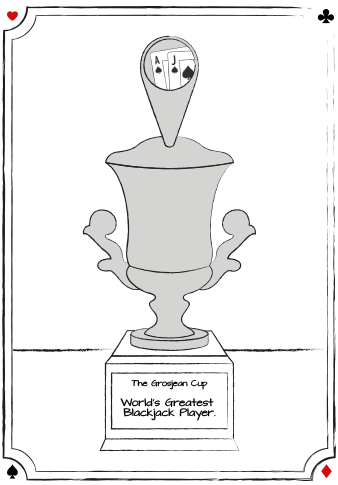
WHAT DOES THE WINNER RECEIVE?
Before 2022, it was bragging rights for one, and an engraved cup signifying him or her as the “World’s Greatest Blackjack Player.” At some of the Balls, the winner also received a tip from James Grosjean on where a juicy advantage play exits (could be anywhere in the world). In 2022, the winner received a Luc Belaire “Rare Luxe” 15 liters, pure white bottle of Brut with the usual imprinted words: “The Grosjean Cup awarded to The ‘World’s Greatest Blackjack Player’ at Max Rubin’s 25th Annual Blackjack Ball.”
Note: Here’s a little history on the Cup. Early on the Cup was called “The Blackjack Ball Cup” but it was renamed the Grosjean Cup because blackjack pro James Grojean won three times and was banned from competing by Rubin; however, to recognize Grosjean for being the best of the best three times, the Blackjack Ball Cup was renamed the Grosjean Cup in his honor. Subsequently, Rubin instituted the Munchkin Award (a smaller Cup) for finishing in second place to honor Richard Munchkin, who also has been banned from the competition after winning three times. Beginning in 2020, and again in 2022, the Cup became the rather large engraved bottle of Luc Belaire “Rare Lux” Brut.
WHAT HAPPENS AFTER THE BALL?
Afterward, there is an optional private party at a different location with more food and drink. This is another opportunity to make new acquaintances or schmooze with old acquaintances. This get-together usually continues until the wee hours of the morning.
KEY TAKEAWAYS
• The Blackjack Ball is a gathering of professional players (active and retired) and others who made a major contribution to our knowledge of blackjack.
• In 2022, the Ball was held at the architecturally-unique, the Cleveland Clinic – Lou Ruvo Center for Brain Health with its large ballroom able to accommodate 180 attendees.
• The Ball consists of a cocktail hour, buffet, Calcutta, voting for the Blackjack Hall of Fame, and the written test and table competition to determine World’s Greatest Blackjack Player.
• Attendees must be invited; men must wear a tuxedo or suit (ladies, formal attire); and guests must pay $250 to attend.
• The Ball is sponsored by Barona casino.
• Attendees are forbidden to play blackjack at Barona.
• The first-place winner receives the engraved Grosjean Cup (aka large bottle of Brut); the runner-up receives the Munchkin Award (a smaller Cup).
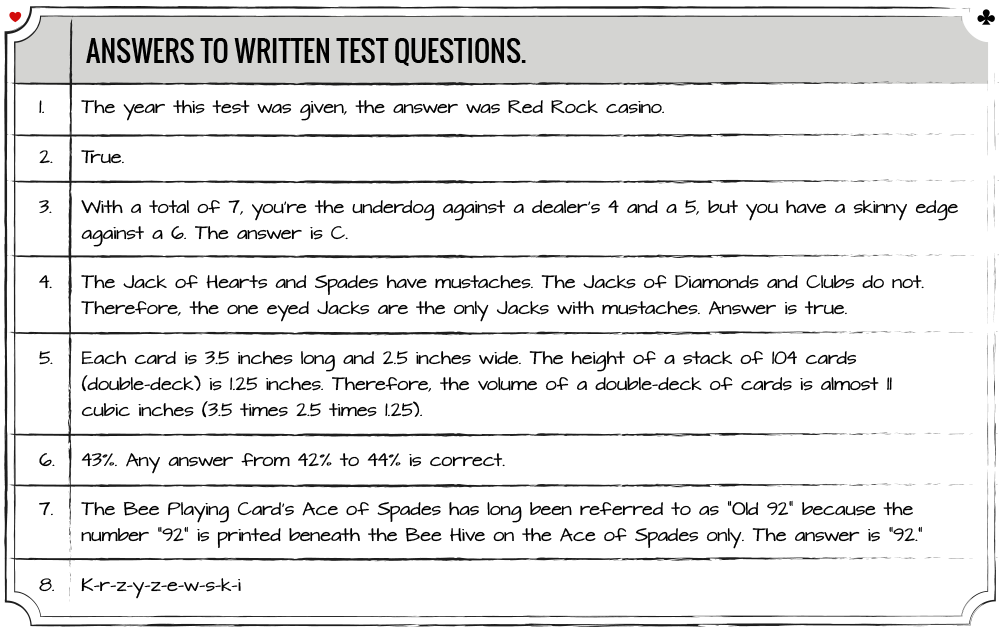
TEST YOURSELF
QUESTION:
- What did the “Four Horsemen of Aberdeen” accomplish?
- Who invented card counting?
- What was the name of the best-selling book from the person in question 2?
- Who was the first person to use high-speed computers to study blackjack?
- Who developed and promoted the Advanced Point Count (A.P.C.) card-counting system and wrote the book Playing Blackjack as a Business?
- Who was the mathematics professor who wrote the book The Theory of Blackjack?
- Who is the famous professional blackjack player who appeared on “60 Minutes”?
- The term “‘wonging” came from which famous blackjack player and author?
- Who developed one of the first unbalanced card-counting systems (Red Seven Count) and is the self-appointed “Bishop of Blackjack”?
- Who developed and published the Illustrious 18?
- Which card counting team was featured in the book Bringing Down the House and in the movie 21?
- The winner of the “World’s Greatest Blackjack Player” competition receives a Cup named after which professional player?
- Name three members of the inaugural class of the Blackjack Hall of Fame.
- Where is the Blackjack Hall of Fame located?
- Where does the voting for the Blackjack Hall of Fame take place?
- Hall of Fame honorees get what from Barona Casino?
- Who attends the Blackjack Ball?
- Where is it located?
- What is the Calcutta at the Blackjack Ball?
- How is the winner of the World’s Greatest Blackjack Player determined?
- Name the two blackjack pros that have won the competition for “World’s Greatest Blackjack Player” competition three times?
Answers
- Developed the first reasonably accurate basic strategy for blackjack.
- Edward Thorp
- Beat the Dealer
- Julian Braun
- Lawrence Revere
- Peter Griffin.
- Ken Uston
- Stanford Wong
- Arnold Snyder
- Don Schlesinger
- M.I.T.
- James Grosjean
- Any three: Al Francesco, Peter Griffin, Tommy Hyland, Arnold Snyder, Edward Thorp, Ken Uston, and Stanford Wong
- Barona Casino
- Blackjack Ball
- Unlimited room, food, and golf privileges for life as long as they never play blackjack at Barona Casino
- Active and retired professional players, and anyone else that has made a contribution to the craft.
- Secret location; no one knows except attendees.
- Contest in which attendees bid on who they think will be a finalist in the competition for the “World’s Greatest Blackjack Player”
- Voting by attendees at Blackjack Ball and members of Blackjack Hall of Fame
- James Grosjean and Richard Munchkin
Written by Henry Tamburin Ph.D.
![]()
